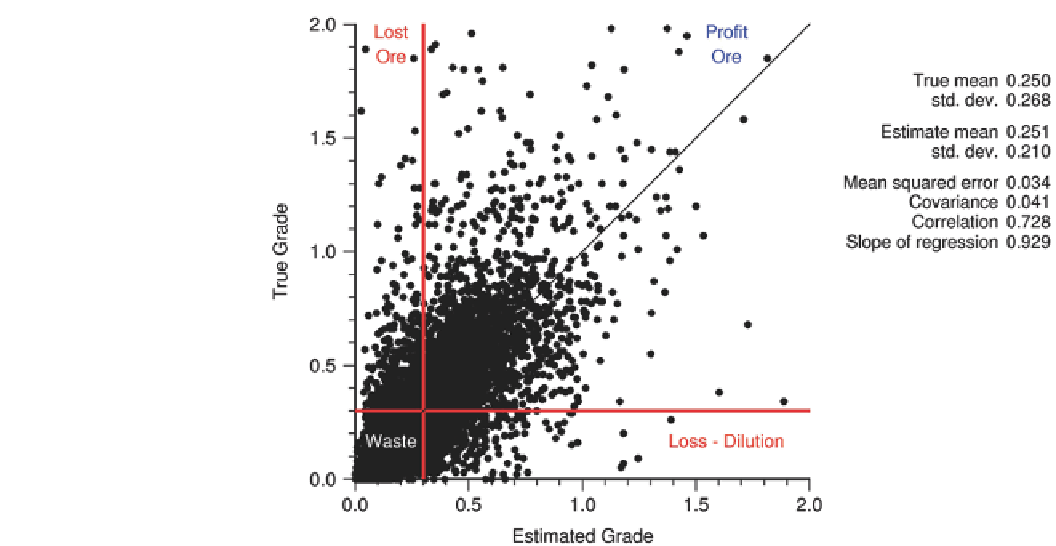Geoscience Reference
In-Depth Information
Fig. 7.11
Scatter Plot of Hy-
pothetical True vs. Estimated
SMU values. The Z
c
= 0.3 cut-
off value defines 4 quadrants
in the graph, two if which cor-
respond to misclassification.
(SMUs represented by dots)
Imperfect selection and other components of the informa-
tion effect are difficult to understand and predict with the
often-used empirical models. The better alternative is to use
geostatistical conditional simulations (Chap. 10), which al-
lows the reproduction, based on simulated data, of the entire
process of blast hole sampling and ore/waste selection, as
discussed in Chaps. 10 and 13, and exemplified in Chap. 14.
This approach has been used successfully in recent years in
practice (Guardiano et al.
1995
; Badenhorst and Rossi
2012
)
and Journel and Kyriakidis (
2004
).
Variants of the probabilistic estimation methods dis-
cussed above in the context of volume-variance correc-
tion (based on Gaussian or Log-normal assumptions) can
be modified to incorporate the information effect. One
such method is advocated by Roth and Deraisme (
2000
),
and is based on a Bi-Gaussian assumption between the
true, unknown SMU value, and its estimate. The Uniform
Conditioning method (as well as others) can be applied to
incorporate a correction to the predicted SMU grades and
tonnages above cutoff.
Besides the more complete and complex conditional
simulation approach, there are several ad-hoc methods that
deal with the information effect. One such method, com-
monly used, is to conservatively bias the ore resource model
(similar to what is shown in Fig.
7.10
) to compensate for the
information effect and future losses. This entails purpose-
fully introducing a certain degree of dilution in the resource
model. As all empirical methods, it can only be successfully
applied if there is sufficient knowledge about the deposit and
valid production data to adequately calibrate the amount of
additional dilution incorporated into the model.
A conceptually similar method consists in defining an
SMU larger than the SMU that the operation can realistical-
ly mine, and assume perfect selection on it. This procedure
compensates for the information effect and the fact that the
theoretical SMU can never be selected (extracted) perfect-
ly, without any further ore loss and dilution. The impact of
assuming a larger-than-expected SMU can be quantified in
terms of additional dilution incorporated into the model.
These empirical methods are subjective, and rely heavily
on assumptions that cannot be easily verified or quantified. As
such, they should be considered only approximations to the in-
corporation of the information effect into the resource model.
The amount of additional data available at the time of ore/
waste selection is significantly more than that available at the
time of developing a resource model for a feasibility study.
Therefore, predictions about mineable tonnage and grades
for economic cutoffs can be much different and improved at
the time of selection, if only because of the massive amount
of information available.
7.5
Summary of Minimum, Good and Best
Practices
The minimum practice in modeling resources requires the
following:
a. All models should have an assessment of the global
internal dilution by estimation domains. This assessment
should be used to quantify the impact of internal dilution,
and compare it with the dilution introduced into the block
model due to the smoothing property of Kriging.
b. The geologic contact dilution should also be included
through geometric considerations if deemed important
enough, or discussed in the documentation of the model
if considered negligible. The methods used could include

